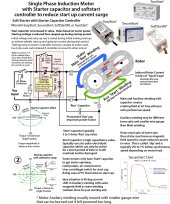Over the past year I've been itching to buy a solar generator minimally capable of reliably powering the 13.5K BTU AC on my travel trailer. I don't need longevity, my AC uses ~1200 watts when running and will ice box my travel trailer within 30 minutes when used before bed, which is what I want to help me get a good nights sleep in the eastern Tennessee summer. Any additional cooling it can sustain after that is bonus. The problem is I've read or or watched video of numerous accounts of these devices (EcoFlow Delta 2000, Bluetti AC200MAX & Anker 767) failing to overcome the surge watts pulled by these ACs. I wish I had been saving the link for each such account but I have the latest, a YT video of an EcoFlow not able to start the AC even with an inline soft start:
.
The EcoFlow and Bluetti devices respectively advertise 5000W and 4800W of surge capability. I can't find a statement from Anker regarding the 767 surge capacity. Based on this metric I would expect the solar generators to easily handle my AC and yet other people with similar ACs report that is not the case.
What I do know is I have a Wen 56225i generator with 2250 surge watts and it can barely manage to start my AC. If I go from Fan Hi to Cool Lo then it can start but will usually fail if I go from Off to Cool Lo.
Can anyone comment on the effectiveness of these LiFePO4 solar generators to handle AC in-rush surge watts? And besides adding a soft start I wonder if there are viable techniques to help the solar generator survive the AC start phase? I have a couple of ideas: 1) A control setting on the device itself to inform it that a surge is coming and it could fully energize the inverter. Or similarly, 2) a specialized circuit breaker to install inline of a high current device like a resistive heater. Turn on the heater first then when the AC comes on the circuit breaker is designed to immediately trip when it detects sudden voltage drop. This leaves the solar generator inverter in high-output state when the AC surge demands start.
Of all the solar generators I really want the Anker 767 and the only thing holding back my purchase is this concern about AC surge watts. I am probably going to buy, try, then return if it doesn't work for me and if so I will chronicle that adventure here.
Thanks all.
The EcoFlow and Bluetti devices respectively advertise 5000W and 4800W of surge capability. I can't find a statement from Anker regarding the 767 surge capacity. Based on this metric I would expect the solar generators to easily handle my AC and yet other people with similar ACs report that is not the case.
What I do know is I have a Wen 56225i generator with 2250 surge watts and it can barely manage to start my AC. If I go from Fan Hi to Cool Lo then it can start but will usually fail if I go from Off to Cool Lo.
Can anyone comment on the effectiveness of these LiFePO4 solar generators to handle AC in-rush surge watts? And besides adding a soft start I wonder if there are viable techniques to help the solar generator survive the AC start phase? I have a couple of ideas: 1) A control setting on the device itself to inform it that a surge is coming and it could fully energize the inverter. Or similarly, 2) a specialized circuit breaker to install inline of a high current device like a resistive heater. Turn on the heater first then when the AC comes on the circuit breaker is designed to immediately trip when it detects sudden voltage drop. This leaves the solar generator inverter in high-output state when the AC surge demands start.
Of all the solar generators I really want the Anker 767 and the only thing holding back my purchase is this concern about AC surge watts. I am probably going to buy, try, then return if it doesn't work for me and if so I will chronicle that adventure here.
Thanks all.



